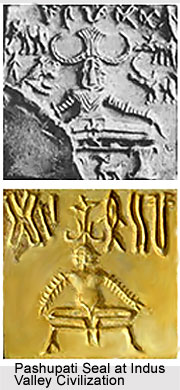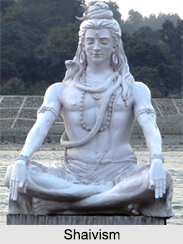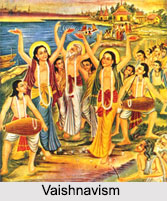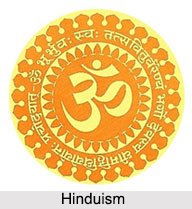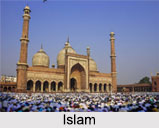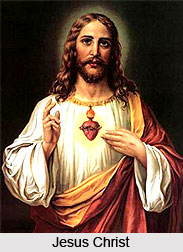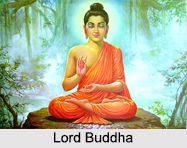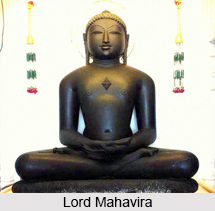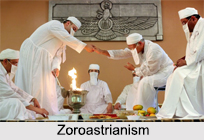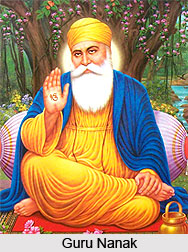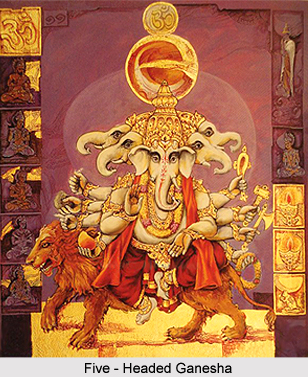 Lord Ganesha is depicted in several forms and is generally conceived with the head of an elephant. The combination of a human body with an elephant head is one of the unique physical features of Lord Ganesha. The deity possesses small eyes of an elephant which represents that He has critical eyesight and a generous mindset. However, the Lord is often shown having more than one head. The Puranas describe Lord Ganesha with a single tusk, elephantine ears, a pot belly and with two or more hands. The lord is sometimes portrayed with three eyes like his father Lord Shiva. The religious scriptures also describe that the deity initially had two tusks but one of them was broken during a combat with Lord Parashurama.
Lord Ganesha is depicted in several forms and is generally conceived with the head of an elephant. The combination of a human body with an elephant head is one of the unique physical features of Lord Ganesha. The deity possesses small eyes of an elephant which represents that He has critical eyesight and a generous mindset. However, the Lord is often shown having more than one head. The Puranas describe Lord Ganesha with a single tusk, elephantine ears, a pot belly and with two or more hands. The lord is sometimes portrayed with three eyes like his father Lord Shiva. The religious scriptures also describe that the deity initially had two tusks but one of them was broken during a combat with Lord Parashurama.
The different physical attributes of Lord Ganesha are discussed as follows-
Variations in Heads of Lord Ganesha
Human-Headed Ganesha
Several Puranic texts mention that Ganesha had a single human head. The Lord was born as a human child but He was decapitated by Lord Shiva. Other legends mention that His head was cut off by Lord Shani. Later the head of an elephant was transplanted on His body at the suggestion of Lord Vishnu.
Boar-Headed Ganesha
Some of the Mahapuranas and Upapuranas also portray Lord Ganesha with the head of a boar.
Two-Headed Ganesha
The two-headed form of Lord Ganesha is very popular in the state of Maharashtra. During the festival of Ganesha Jayanti various idols of the deity in this form can be found. This form is generally known as Dwimukha Ganapati. Moreover the Simha Ganapati form is depicted with the head of a lion and the head of an elephant.
Three-Headed Ganesha
 This form of the Lord is known as Trimukha Ganapati. He is portrayed in red complexion and has four or six arms. The deity is seated in the centre of a golden lotus throne. In a temple in Karnataka, a sculpture of the three-headed Ganesha is installed. The right face of the idol is the face of a monkey which represents Lord Hanuman; the left face is that of Lord Garuda; and the central face is of an elephant. The trunk of the idol is curled towards the left holding a modaka or sweet ball.
This form of the Lord is known as Trimukha Ganapati. He is portrayed in red complexion and has four or six arms. The deity is seated in the centre of a golden lotus throne. In a temple in Karnataka, a sculpture of the three-headed Ganesha is installed. The right face of the idol is the face of a monkey which represents Lord Hanuman; the left face is that of Lord Garuda; and the central face is of an elephant. The trunk of the idol is curled towards the left holding a modaka or sweet ball.
Five-Headed Ganesha
The five-headed form of Lord Ganesha is known as Heramba Ganesha. He is portrayed with five faces and ten arms in this form. The hands of Ganesha hold an apple, a Rudraksha a goad, a tusk, an axe, a rope and a modaka. His vahana or mount is a lion.
Eyes of Lord Ganesha
The Hindu religious scriptures generally define the elephant-headed deity with two eyes. However in some of the texts, Ganesha is depicted with three eyes as well, where the third eye is located horizontally at the centre of the forehead. The colour of the eye is widely prescribed as red in colour.
Ears of Lord Ganesha
The ears of the elephant-headed Lord are those of an elephant. In the Puranas His ears are described as Surpakarnas.
Trunk of Lord Ganesha
The trunk of the elephant-faced Lord is generally curved towards the left side but it`s often depicted as curled towards the right side. The trunk is turned towards the left in order to pick up the modakas or sweet balls that are placed in a plate in His left hand. As His trunk is curved, Lord Ganesha is also known as Vakratunda.
Complexion of Lord Ganesha
The different forms of Lord Ganesha are depicted in different complexions, such as fair, blue, vermilion red, yellow, golden, scarlet, turmeric yellow and others.
Facial Expression of Lord Ganesha
Lord Ganesha, the Lord of Obstacles, is widely portrayed in a smiling face (Prasannavadana). He also has the shine of the rising sun and the moon.
Yajnopavita of Lord Ganesha
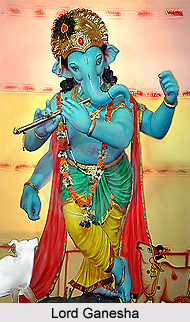 The Yajnopavita or sacred thread of Lord Ganesha is of a serpent. Moreover a snake is also used as a girdle with its hood at the navel. The deity tied the snake around His waist to hold modakas inside His stomach.
The Yajnopavita or sacred thread of Lord Ganesha is of a serpent. Moreover a snake is also used as a girdle with its hood at the navel. The deity tied the snake around His waist to hold modakas inside His stomach.
Head-dress and Ornaments of Lord Ganesha
The forehead of the Lord is adorned with the tilak of vermilion and His head is graced with a Kirita Mukuta. The crown was gifted by Lord Kubera. The Puranic texts also mention that a crescent moon is also placed above His head like Lord Shiva. The deity is adorned with gold ornaments.
Moreover, the Ganesha Purana cites that the feet of the Lord are adorned with various auspicious symbols like a sacred flag, Urddhvarekha lotus, a goad and others.
Costumes of Lord Ganesha
Lord Ganesha is mostly depicted in red and yellow garments. But He is also shown in deer skin and tiger skin. Moreover, the Lord is presented in different garments in the different forms.
Arms of Lord Ganesha
The Lord is presented with multiple arms in various religious texts. According to the Ganesha Purana, Mahotkata Vinayaka in the Satya Yuga or Krita Yuga had 10 arms with a lion as his vahana; Mayuresvara in the Treta Yuga had six arms and mounted over a peacock; the Gajanana form in Dwapara Yuga possessed four arms and mounted on the divine mouse Krauncha; and the Dhumraketu form in Kali Yuga has two arms and a blue horse as his mount. A Jain scripture named Ganapati Pratistha Vidhi prescribes Ganesha with two arms, four arms, six arms, nine arms and eighteen arms. These are mentioned as follows-
Two-Armed Ganesha
In various images of the deity, Ganesha is shown having two arms. The sculptures of the Lord found in various temples, such as bronze Ganesa from Palliyar Patti, Tamil Nadu; Ganesa from Bhikavalu; Baiamannu Ganapati from Karkola; Ganesa from Siddhataka; Ganesa from Ranjangaon, Maharashtra; and Mayuresvara Ganapati from Monegaon, are all two armed Ganesha idols.
Four-Armed Ganesha
The images of Lord Ganesha are generally depicted with four arms. Several sculptures like the three-headed Vinayaka from Karnataka; Dhundhi Ganapati from Varanasi; a bronze Ganesha from Tiruvarur and others, are presented with four hands. A bronze idol of Ganesha from Tiruvarur shows the elephant god in a seated posture holding a pen in His upper right hand and a manuscript in the upper left hand.
Six-Armed Ganesha
The forms of Pingala Ganapati (Siddhi Ganapati), Urdhva Ganapati and Taruna Ganapati are presented with six hands. He carries various items in different forms, such as modaka, sugarcane, mango, bunch of flowers, ankusa, seasamum, wood-apple, paddy, His own broken tusk, parasu, sugarcane bow, bamboo stick, bana and kalhara flower. He also embraces His consort (Shakti) with one of his hands. A stone statuette of dancing Ganesha at Rajashahi shows the Lord with six arms.
Eight-Armed Ganesha
The Lord is portrayed with eight arms in some of His forms, such as Nritya Ganapati, Lakshmi Ganapati, Bhavanesha Ganapati, Durga Ganapati, Simha Ganapati, Heramba Ganesha and Taruna Ganapati. The Lord carries different objects in different incarnations, like His own broken tusk, a pomegranate, sugarcane bow, battle axe, kalpalata, ankusa, paddy grass, a parrot, a conch shell, a bejewelled kamandalu, a noose, a ring, sweets, lotus, chakra and bana. One of the hands displays the Abhaya Mudra and another hand embraces His consort.
Ten-Armed Ganesha
The forms of Mahotkata Vinayaka and Maha Ganapati are portrayed with ten arms. In His hands, Ganesha carries sugarcane, pasa, ears of paddy, a jewelled Kamandalu, a pomegranate, lotus flower, His own broken tusk, a noose, a goad, modakas etc. The sculpture of Maha Ganapati form in Madurai, Tamil Nadu is shown with ten arms riding on a mouse.
Twelve-Armed Ganesha
The twelve-armed incarnation of the elephant-headed Lord is a Tantric form. He is described as Ganapati in the Sadhanamala and Vighnaraja Ganapati in the Rudrayamala tantra. The deity carries a scarf, kapala of dried meat, a skull filled with blood, khatvanga, a bow, a musala, sula, a sword, a vajra, a goad, an arrow and a battle axe.
Sixteen-Armed Ganesha
The Vira Vighnesha form of Lord Ganesha is required to be depicted with sixteen arms. He carries a sword, a shield, a noose, a goad, bow and arrows, battle axe, trident, mudgara, a flag, vampire etc. He also embraces His consort (Shakti) with one of the hands.
